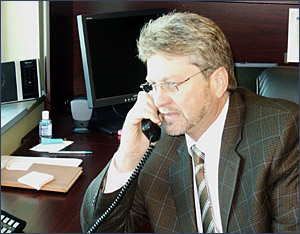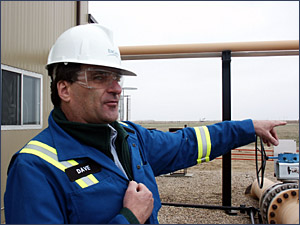|
Preventing a Climate Catastrophe
by John Rudolph
part 1 2 3 4 5
Capturing Carbon Dioxide
Even if the Great Conveyor Current never shuts down, scientists believe the world may still have to contend with extreme climate change. The answer to this challenge, they say, is to make major reductions in greenhouse gas emissions.
 |
Mike Monea is and 'oil man turned environmentalist' at the Petroleum Technology Research Centre at the University of Regina in Saskatchewan. - photo by John Rudolph |
In some places, this is already starting to happen.
We drive across the plains of the Canadian Midwest to the Weyburn oil field with our guide, Mike Monea, an oil-man turned environmentalist. He heads the Petroleum Technology Research Centre at the University of Regina in Saskatchewan.
"They have a joke here that you can watch your dog run away for three days, it's so flat. It's all beautiful wheat fields. We'll be coming up on our oil field very shortly, and there are literally tens of thousands of wells that'll be in the oil field."
Before he came to work at the university, Mike Monea ran his own oil company. In those days, he barely thought about global warming, but since entering academia less than two years ago, Monea has become a believer. Abrupt climate change, he says, is a threat.
"Probably my turning point was seeing data on ice core samples in the last 100 years. When you start looking at the statistics on the melting of some of our arctic ice, and the impact that fresh water is going to have on, say, the circulation of oceans, it's huge. That really got my attention."
Driving around Weyburn, you see hundreds of pump jacks slowly bobbing up and down as they suck black crude out of the ground, and as the oil comes out, carbon dioxide is being pumped in. At Weyburn, millions of tons of carbon dioxide have been liquefied and then injected into the oil wells. The CO2 is literally being buried underground where it can't contribute to global warming.
 |
Dave Craigen - photo by John Rudolph |
Dave Craigen works for Encana Corporation, the company that owns the sprawling 70-square-mile oil field. They've been producing oil here since 1954, which makes Weyburn a very old oil field. But you can extend the life of old oil wells by pumping them full of liquefied carbon dioxide. CO2 increases the pressure in underground oil reservoirs. It also acts as a solvent, thinning the crude and making it easier to bring to the surface.
This method's been used in west Texas for a couple of decades. In Texas, any CO2 that comes up with the oil is usually allowed to escape into the atmosphere, but at Weyburn, carbon dioxide that returns to the surface is captured at the wellhead. It's then re-injected to help extract more oil.
Unlike the United States, Canada has a national policy to reduce greenhouse gas emissions, and Weyburn represents one small step toward meeting that goal.
Craigen explains, "It's almost as if there are two projects. There's enhanced oil recovery, or EOR, and that's what the oil industry's interested in. And then there's the geological sequestering of a greenhouse gas, which is what the science community is interested in."
Next - Is Underground Storage the Answer?
|

